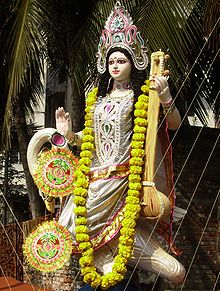Saraswati
![]()
This article is about the Hindu goddess. For the mythological river of the same name, see Sarasvati (river).
Sarasvati (Sanskrit सरस्वती Sarasvatī f., "the flowing one", in Bali Saraswati) is an Indian goddess of wisdom and learning and one of the most popular Hindu goddesses. In Tantra, she enjoys veneration as the blue or dark Sarasvati. She is said to have evolved from the Vedic language goddess Vac.
Sarasvati is considered to be the female power (Shakti) of the god Brahma and the female personification of the absolute source Brahman. Hindu mythology depicts her as the daughter, creation and wife of Brahma. To this she seems subordinate; in the practice of faith, however, worship is mainly directed to her, while the worship of Brahma has largely disappeared. As Vac ("Word", "Logos"), another name, she embodies the Word personified, the perfect speech. Other epithets are Mahavidya ("the great wisdom"), Brahmani ("wife of Brahma"), and Jagaddhatri ("mistress of the world"). The goddess Gayatri is also often identified with her. Sarasvati is the goddess of learning, language, sciences, arts, poetry, literature, writing, wisdom, dance, song and music. She is considered the "Mother of the Vedas", inventor of the Sanskrit alphabet and the Devanagari script. She is particularly revered by school children, students, philosophers and intellectuals. In an important book of the devotees of the goddess, the Devi Mahatmyam, she forms one of the female Trimurti as eight-armed Maha Sarasvati (great Sarasvati) together with Maha Kali as well as Maha Lakshmi.

The goddess Sarasvati on a temporary altar on her feast day Vasant Panchami, in her left hand her instrument, the Vina
Sarasvati in the Vedas
In the Apri songs (āpriyas), a text form of the Rig Veda, Sarasvati forms a trinity with Ida and Bharati (Mahi). She was originally described as a nature and river goddess, hence she is still associated with pure water and the mythical Soma. She embodied the sacred river Sarasvati, which is said to have had its origin in heaven and to have run through all three worlds (Triloka). Sarasvati was primarily a goddess of fertility. Her voice was the waterfall, and she possessed the power to blast mountains. She is also said to have defeated, or at least helped defeat, the demon Vritra instead of Indra.
Iconography, symbolism and myths
The iconography shows Sarasvati in the middle of a lake, the primordial water, which is interpreted among other things as a symbol for the beginning of creation. She thus identifies herself as the creator of the universe, just like her husband Brahma. As a beautiful young woman, often with four arms, she carries the vina (an ancient stringed instrument still played today) as her most distinctive sign; she also carries a mala (prayer chain) and a book, the Vedas and a water pot. Or they are depicted with two arms, with vina and various mudras (hand gestures), especially the gesture of reasoning. Also other emblems like wheel, club, conch or bell, hourglass and skull bowl are occasionally found. Her attendant animal (vahana) is the goose or a swan (hamsa), in South Indian representations also a peacock. The beautiful and spirited goddess stands or sits on a lotus, a sign of her beauty as well as her wisdom. She is also considered to be the embodiment of purity, which is also expressed by the characteristic colour of her clothing, a radiant white. Often she is also dressed in yellow. There is also overlap with the goddess Lakshmi, as both are considered to be the consorts of Vishnu. She is said to have a tense relationship with her (often philosophically interpreted as an irreconcilable opposition between wealth and wisdom).
According to Hindu mythology, Sarasvati was born from Brahma. Brahma had the desire to bring forth creation and went into meditation. Thereupon, his body divided into a male half and a female half - Sarasvati. According to other versions, she sprang from his head. Brahma united with her and Manu, the progenitor of mankind, was born. It is often said that Sarasvati came from the mouth of Brahma when he created the world through his creative speech. Later, when Sarasvati was not present at an important ritual, but a wife was needed, Brahma created out of himself his second wife Gayatri to perform the ritual. When Sarasvati returned and learned of this, she condemned her husband to be worshipped only one day a year.
In another, less popular myth, the goddess arises from Krishna. The latter divided himself into male and female, spirit and matter, Purusha and Prakriti, to create the world. The female half took the form of five dynamic forces or goddesses, one of whom was Sarasvati.

Woodcut miniature from 1875, sold at the Kalighat temple in Calcutta as a souvenir for pilgrims.
Search within the encyclopedia